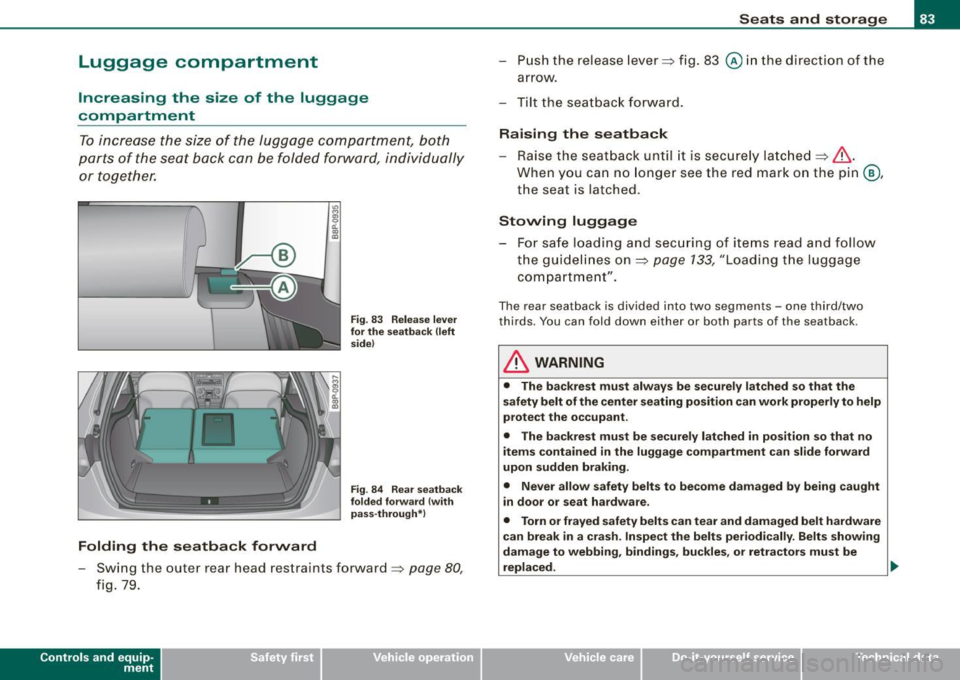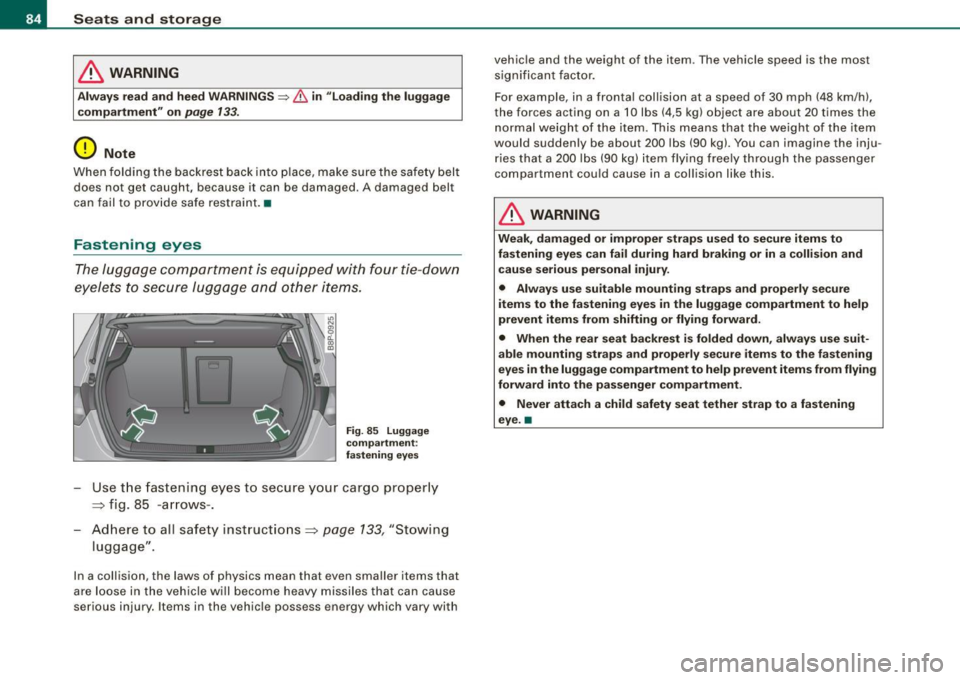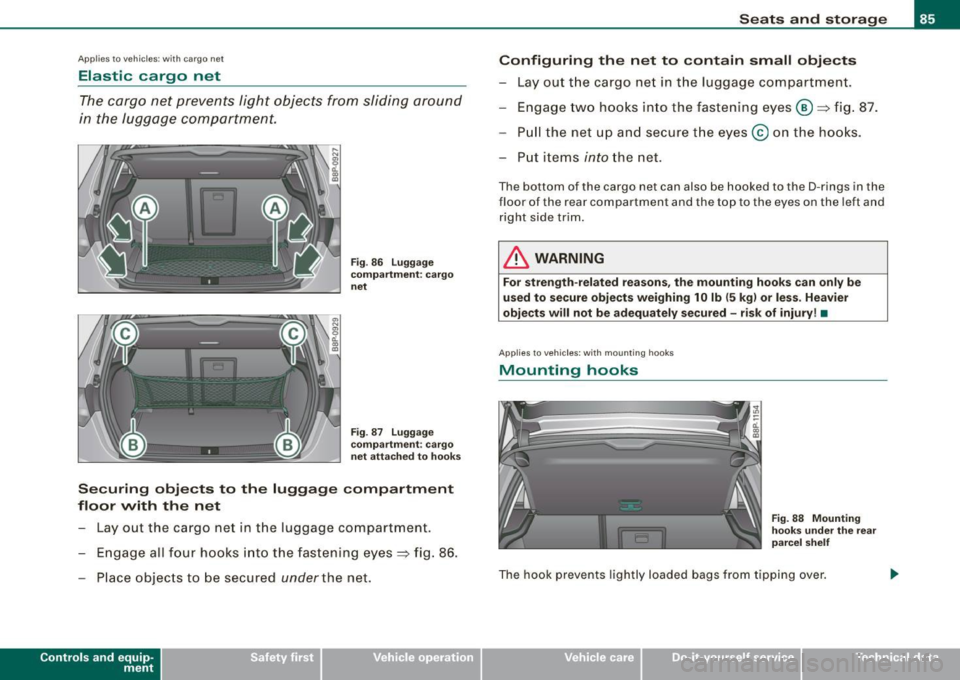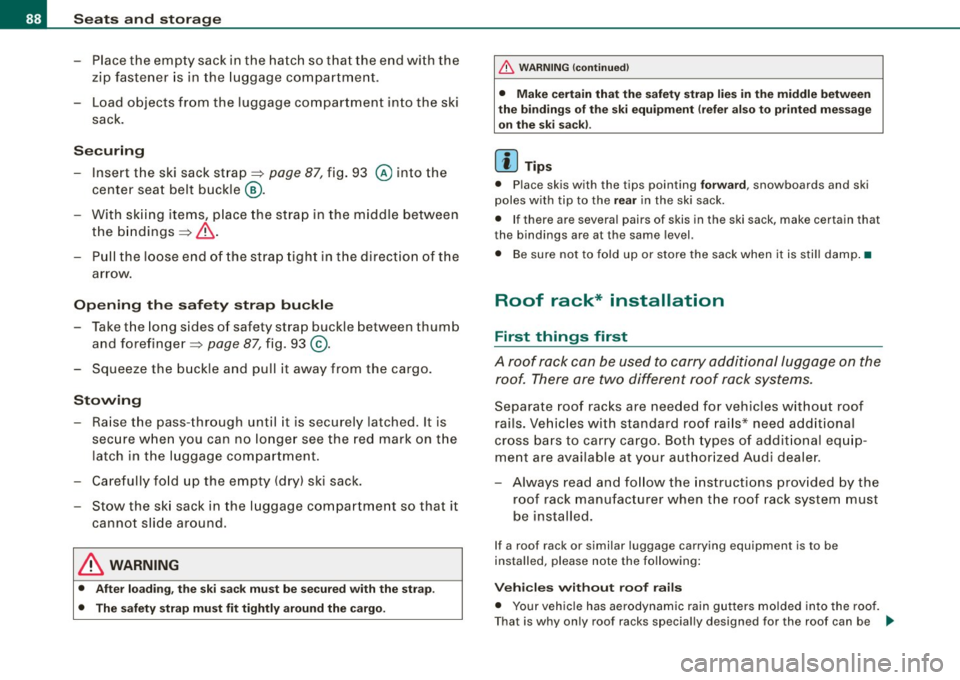AUDI S3 2009 Manual Online
Manufacturer: AUDI, Model Year: 2009, Model line: S3, Model: AUDI S3 2009Pages: 324, PDF Size: 76.02 MB
Page 81 of 324

Head restraints
Adjusting head restraints, front seats
The head restraints must be properly adjusted to the
occupants's height to provide optimal restraint in combi
nation with the seat restraints.
Fig . 78 Driver's seat
head restraint:
adjusting the height
The head restraints on the front seats can be adjusted to
provide safe support to head and neck at the optimum
height. Optimally adjusted, the top of the restraint should
be level with the top of the head.==>
page 131, "Proper
adjustment of head restraints".
Raising head restraint
-Grab the sides of the head restraint.
- Lift the head restraint ==>
page 79, fig. 78 until the top of
the restraint is even with the top of your head
==>
page 131
Lowering head restraint
- With one hand push down on the middle of the head
restraint.
Con tro ls and eq uip
ment
Seats and storage
- With the other hand press the release knob@
==> page 79, fig. 78 and push the head restraint down. You
should
not lower the top of the restraint below the level
of your eyes.
Removing the head restraint
-Pull the head restraint all the way up.
- Press the release button -arrow- ==>
page 79, fig. 78 and
pull the restraint straight up and out of the seat.
Installing the head restraint
- Insert the rods into the guides and push the restraint
back in until you hear it click.
Refer to~ page 131, "Proper adjustment of head restraints" for
guidelines on how to adjust the height of the front head restraints
to fit the occupant's body size.
& WARNING
• Driving without head restraints or with head restraints that are
not properly adjusted increases the risk of serious or fatal neck
injury dramatically.
• Read and heed all WARNINGS ~
page 131.
[ i] Tips
Correctly adjusted head restraints and safety belts are an extremely
effective combination of safety features. •
Vehicle care
I I irechnical data
Page 82 of 324

Seats and stor ag e
Rear head restraints (outer seating positions)
Fi g. 79 Ou te r re ar
h ea d re stra ints:
a dju sting th e heigh t
When t he rear seats a re no t occupied, you can l ower the
head rest raints (park p osition) and obtain better rearward
v1s 1on.
Moving the h ead r estraints to the "in-us e
position "
Grasp the sides of the head restraint with both hands .
- Move the head restraint to the uppermost pos ition
=> fig. 79 G) until it latches (in -use posit ion).
Moving the head restraints to the "park
position "
Press the re lease butto n
=> page 80, fig. 79 @ .
- Grasp the s ides of the head restraint with both hands.
- Press the head restraint down until it lies against the seat
back @ (park position) .
Removing the head restraints
- Move t he head restraint upward as far as it can go . - Press the button
@ => page 80, fig. 79 and pu
ll the head
restraint out a t the same t ime .
Installing head r estraints
- Pus h the rods for the head restraint into the guides until
they latch with an audible click .
Refer to=> page 131, "Proper adjustment of head restraints" for
guide lines on how to adjust the height of the outer head restraints
to fit the occupant's body size .
& WARNING
• Drivi ng w ithout head re str ai nt s or with head re str aint s tha t are
no t properly adju sted incr ease s the ri sk of seriou s or fatal n eck
i nj ury dr amatic ally .
• Read and h eed all WARNING S=>
page 13 1
[ i ] Tips
Correctly adjusted head restraints and safety belts are an extremely
effective combination of safety features .•
Rear head restraint (center seating position )
---o:, --~ - en - 0 -
he ad restra int:
a dju sting t he height ..
Page 83 of 324

When the rear seats are not occupied, you can lower the
head restraints (park position) and obtain better rearward
vision.
Moving the head restraints to the "in-use
position"
- Grasp the sides of the head restraint with both hands.
- Move the head restraint to the uppermost position
=> fig. 80 G) until it latches (in-use position).
Moving the head restraints to the "park
position"
- Press the release button => fig. 80 @.
- Grasp the sides of the head restraint with both hands.
- Press the head restraint down until it lies against the seat
back @ (park position) .
Removing the head restraints
-Take the screwdriver from the vehicle tool kit
=> page 270.
-Move the head restraint upward as far as it can go.
- Press the release button
@ => page 80, fig. 80 and pull
the head restraint upward as far as it can go at the same
time.
- Insert the screwdriver at position @ into the recess and
pull out the head restraint at the same time.
Installing head restraints
- Push the rods for the head restraint into the guides until
they latch with an audible click.
Con tro ls and eq uip
ment
Seats and storage
The height of the center head restraints is adjustable. They should
be adjusted to fit the occupant's body size. Correctly adjusted head
restraints and safety belts are an extremely effective safety feature
=> page 131.
& WARNING
Read and heed all WARNINGS=> page 131, "Proper adjustment of
head restraints". •
Center armrest
The front center armrest can be adjusted to several posi
tions and contains a storage bin.
Adjusting the armrest
-Push the armrest down.
Fig . 81 Between the
front seats: armrest
folded down
-Lift the armrest slowly until it is in a comfortable posi-
tion.
Opening the storage bin
- Pull the release button => fig. 81 upward.
Vehicle care I I irechnical data
Page 84 of 324

Seats and storage
& WARNING
When folded down, the armrest can restrict the driver's move
ment. When driving in conditions that may call for quick maneu
vers , fold up the armrest. This will allow you to react more quickly
to avoid an accident. •
Rear seats
General information
Safe transpo rtation of passengers on the rear seats
requires proper safety precautions.
All passengers on the rear seats must be seated in compliance with
the safety guidelines explained in=> page
137 and=> page 147. The
correct seating position is safety critical for front
and rear seat
passengers alike=> page
130.
& WARNING
• Vehicle occupants in the front and rear seats must always be
properly restrained.
• Do not let anyone ride in the vehicle without the head restraints
provided . Head restraints help reduce injuries .
• Loose items inside the passenger compartment, can fly
forward in a crash or sudden maneuver and injure occupants .
Always store articles in the luggage compartment and use the
fastening eyes, especially when the rear seat backs have been
folded down .
• Read and heed and all WARNINGS =>
page 130, "Proper seating
positions for passengers in rear seats ".•
Rear armrest
The armrest contains a storage compartment and a
cupholder for 2 drinks.
Folding dovvn the armrest
Fig. 82 Center of the
rear seatbench: rear
armrest folded down
-Pull the armrest down on the front :::} fig. 82.
Opening the storage bin
- Pull the handle in front. •
Page 85 of 324

Luggage compartment
Increasing the size of the luggage
compartment
To increase the size of the luggage compartment, both
parts of the seat back can be folded forward, individually or together.
Folding the seatback forward
U')
"'
"' 0 a. ., CD
Fig . 83 Release lever
for the seatback (left
side)
Fig . 84 Rear seatback
folded forward {with
pass-through*)
- Swing the outer rear head restraints forward=> page 80,
fig. 79.
Con tro ls and eq uip
ment
Seats and storage
- Push the release lever=> fig. 83
@ in the direct ion of the
arrow.
- Tilt the seatback forward.
Raising the seatback
- Raise the seatback until it is securely latched=>& .
When you can no longer see the red mark on the pin@,
the seat is latched .
Stowing luggage
- For safe loading and securing of items read and follow the guidelines on=> page
133, "Loading the luggage
compartment".
The rear seatback is divided into two segments -one third/two
thirds. You can fold down either or both parts of the seatback .
& WARNING
• The backrest must always be securely latched so that the
safety belt of the center seating position can work properly to help
protect the occupant.
• The backrest must be securely latched
in position so that no
items contained in the luggage compartment can slide forward
upon sudden braking.
• Never allow safety belts to become damaged by being caught
in door or seat hardware.
• Torn or frayed safety belts can tear and damaged belt hardware
can break in a crash. Inspect the belts periodically. Belts showing
damage to webbing, bindings, buckles, or retractors must be
replaced.
~
Vehicle care I I Technical data
Page 86 of 324

Seats and storage
& WARNING
Always read and heed WARNINGS => & in uloading the luggage
c ompartment " on
page 133 .
0 Note
When folding the backre st back into place, make su re the safe ty belt
does not get caught, because it can be damaged . A damaged belt
can fail to p rov ide safe restraint. •
Fastening eyes
The luggage compartmen t is e qui pped with four tie -down
eyele ts to secure lug ga ge and o ther items .
Fig. 85 Lugg age
compartment :
fa stening eyes
Use t he fastening e yes to secu re you r ca rgo pr oper ly
=> fig. 85 -a rr ow s-.
- Ad here to all safet y instruc tions => page 133, "Stowing
lugg age".
In a collision, the laws of physics mean that even smalle r items that
a re loo se in t he vehi cle will bec ome he avy missiles that ca n ca use
se rious inju ry . I tems in the vehicle possess e nergy which vary with vehicle and the weight of the item
. T he vehicle speed is the most
significan t factor.
For exam ple, in a fronta l collision at a speed of 3 0 mph (48 km/h),
the forces acting on a 10 lbs ( 4,5 k g) object are about 20 times the
n ormal w eight of th e ite m. Th is mea ns that the weight of the it em
woul d suddenly be about 200 lbs (90 kg). You can imagine the inju
ri es th at a 20 0 lb s (90 kg) item fl ying fr ee ly t hroug h the passe nge r
compartment cou ld cause in a co llis ion li ke this.
& WARNING
Weak , damaged or improper straps used to secure items to
fastening eyes can fail during hard braking or in a collision and cause serious personal injury .
• Always use suitable mounting straps and properly secure
items to the fastening eyes in the luggage compartment to help
prevent items from shifting or flying forward.
• When the rear seat backrest is folded down , always use suit
able mounting straps and properly secure items to the fastening
eyes in the luggage compartment to help prevent item s from flying
forward into the passenger compartment .
• Never attach a child safety seat tether strap to a fastening
eye. a
Page 87 of 324

Applies to vehic les: w it h ca rgo ne t
Elastic cargo net
The cargo net prevents light objects from sliding around
in the luggage compartment.
Fig . 86 Luggage
compartment : cargo
net
Fig . 87 Luggage
compartment : cargo
net attached to hooks
Securing objects to the luggage compartment
floor with the net
- Lay out the cargo net in the luggage compartment .
- Engage all four hooks into the fastening eyes~ fig. 86.
- Place objects to be secured
under the net.
Con tro ls and eq uip
ment
Seats and storage
Configuring the net to contain small objects
- Lay out the cargo net in the luggage compartment.
- Engage two hooks into the fasten ing eyes ®~ fig. 87.
- Pull the net up and secure the eyes @ on the hooks.
Put items
i nto the net.
The bo ttom of the cargo ne t can al so be hooked to the D-rings in the
floor of the rear compartment and th e top to the eyes on the left and
right side t rim.
& WARNING
For strength-related reasons, the mounting hooks can only be
used to secure objects weighing 10 lb (5 kg) or less . Heavier
objects will not be adequately secured -risk of injury! •
Applies to v ehic les: with mo unt ing hooks
Mounting hooks
Fig . 88 Mounting
hooks under the rear
parcel shelf
The hook prevents lightly loaded bags from tipping over.
Vehicle care I I Technical data
Page 88 of 324

Seats and storage
& WARNING
For strength-related reasons, heavy objects must not be hung on
the hooks. Heavy objects are not adequately secured -this
increases the risk of injury. •
Retractable luggage compartment cover
The luggage compartment cover keeps luggage or other
objects out of view.
Fig. 89 Rear lid open
with luggage compart ment cover
Removing the luggage compartment cover
Detach the retaining straps=> fig. 89 at the rear hatch G).
-Pull the cover 0 horizontally out of the mount@ in the
direction of the arrow.
Installing the luggage compartment cover
- Push the cover horizontally into the mounts provided
=> fig. 89@ on the side panel until the cover seats.
- Install the retaining straps in the rear hatch => fig. 89
G)
=>& .
& WARNING
• The luggage compartment cover must never be installed
without being secured -this creates an accident hazard.
• Whenever driving, never place any hard or heavy objects on the
luggage compartment or allow pets to sit on the luggage compart
ment cover . They could become a hazard to vehicle occupants in
the event of sudden braking or in an accident.
0 Note
Make sure that the heating wires in the rear lid do not get damaged
by objects scraping against them.
[ i ] Tips
• You can use the luggage compartment cover to store light
weight clothing but do not leave any heavy or sharp objects in the
pockets of the clothing.
• Remember that placing clothing on the luggage compartment
cover can block the driver's vision in the rear view mirror. This also
applies especially when you have to transport large objects.
• So that stale air can escape from the vehicle be sure not to cover
the ventilation slot between the rear lid and the luggage compart
ment cover installed. •
Page 89 of 324

Applies to vehic les: w ith revers ible cargo area floor
Reversible cargo area floor (protective liner )
Use the protective liner when transporting dirty or wet
objects .
Reversing the cargo area floor
-Open the luggage compartment lid.
Fig. 90 Luggage
compartment : cargo
area floor
Fig . 91 Luggage
compartment : protec
tive liner
-Raise the cargo area floor at both handles=> fig. 90,
remove it
G) and rotate it 180 degrees @.
- In sert the reversed cargo area floor (protective liner)
again => fig. 91 . •
Con tro ls and eq uip
ment
Seats and storage
App lies to vehicles: w ith s ki sack
Ski sack
The ski sack allows a maximum of 4 pairs of skis or 2
snowboards to be carried inside the vehicle .
Loading
-Open t he rear hatch.
Fig . 92 Section of the
rear seat from the rear:
ski sack hatch cover
Fig. 93 Securing the
ski sack at the center
rear seat belt buckle
- Slide the release button for the pass -through down (with
the center arm rest)=> fig. 92 -Arrow- and tilt the pass
through forward.
- Remove the sack from the luggage compartment and
unfold it.
Vehicle care I I irechnical data
Page 90 of 324

Seats and storage
-Place the empty sack in the hatch so that the end with the
zip fastener is in the luggage compartment.
- Load objects from the luggage compartment into the ski
sack.
Securing
- Insert the ski sack strap ~ page 87, fig. 93 @ into the
center seat belt buckle
® ·
- With skiing items, place the strap in the middle between
the bindings ~& .
- Pull the loose end of the strap tight in the direction of the
arrow.
Opening the safety strap buckle
- Take the long sides of safety strap buckle between thumb
and forefinger ~
page 87, fig. 93 @.
- Squeeze the buckle and pull it away from the cargo.
Stowing
- Raise the pass-through until it is securely latched. It is
secure when you can no longer see the red mark on the
latch in the luggage compartment.
- Carefully fold up the empty (dry) ski sack.
- Stow the ski sack in the luggage compartment so that it
cannot slide around.
& WARNING
• After loading, the ski sack must be secured with the strap .
• The safety strap must fit tightly around the cargo.
& WARNING (continued)
• Make certain that the safety strap lies in the middle between
the bindings of the ski equipment (refer also to printed message on the ski sack).
[ i] Tips
• Place skis with the tips pointing forward, snowboards and ski
poles with tip to the
rear in the ski sack.
• If there are several pairs of skis in the ski sack, make certain that
the bindings are at the same level.
• Be sure not to fold up or store the sack when it is still damp. •
Roof rack* installation
First things first
A roof rack can be used to carry additional luggage on the
roof. There are two different roof rack systems.
Separate roof racks are needed for vehicles without roof
rails. Vehicles with standard roof rails* need additional
cross bars to carry cargo. Both types of additional equip
ment are available at your authorized Audi dealer.
- Always read and follow the instructions provided by the
roof rack manufacturer when the roof rack system must
be installed.
If a roof rack or similar luggage carrying equipment is to be
installed, please note the following:
Vehicles without roof rails
• Your vehicle has aerodynamic rain gutters molded into the roof.
That is why only roof racks specially designed for the roof can be .,,